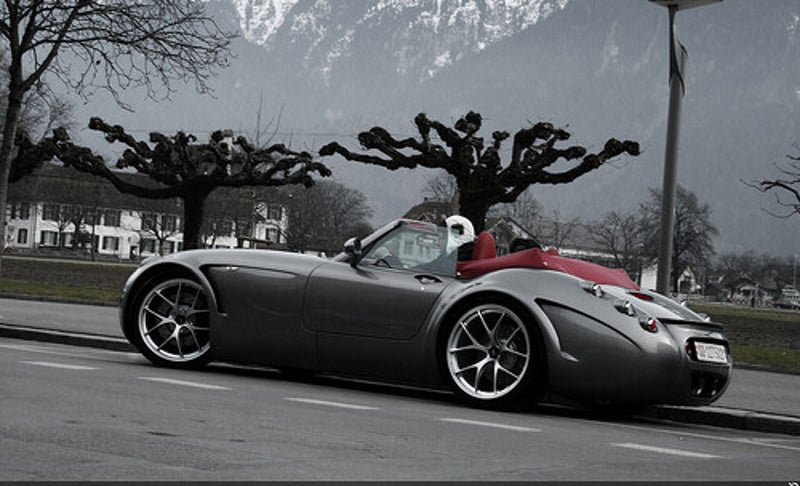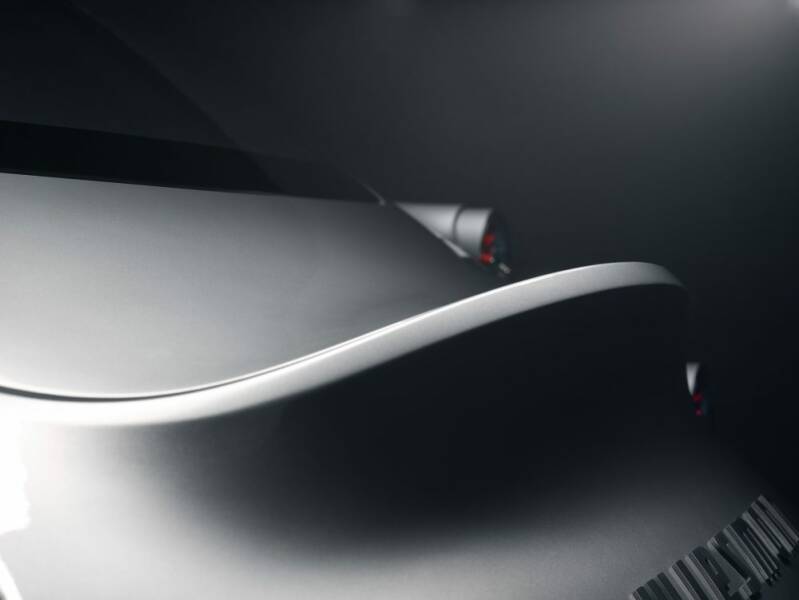


Wiesmann GmbH is a German automobile manufacturer that specialises in hand-built custom convertibles. The company, which has its factory in Dülmen, was founded by brothers, engineer Martin Wiesmann and businessman Friedhelm Wiesmann, in 1988. The business was temporarily closed in May 2014, and following a buyout by London based investor Roheen Berry who took over as CEO, it is set to return with a new model, powered by a BMW M division-sourced V8 engine. The relaunch of the Wiesmann brand has more than one model, including an electric vehicle, in the pipeline and the pre-development phase of the car has been completed. A teaser video of the brand's rebirth, posted on their website, tells viewers to “expect the unexpected”, while showing glimpses of what could be the first car of the brand's new era.
In its previous era, Wiesmann used BMW six-cylinder engines to power its MF models, until the introduction in 2003 of the GT MF4, which used BMW's 4.8-litre V8, and the MF 5, which used the M5's 5.0-litre V10.

The company's first roadster left the workshop in 1993. By 2006, they were producing the Wiesmann MF 3 and MF 30 roadsters and the Wiesmann GT MF 4 coupé, all of which utilized engine and transmission components supplied by BMW. The company, which made around 180 hand-built cars each year, used a gecko logo because they claimed their cars "stick to the road like geckos to a wall"
Wiesmann planned to begin exporting vehicles to the US by 2010, however, factors including a poor exchange rates and the high costs of modifying and testing cars in order to make them road-legal in the US stymied these plans. On August 14, 2013 Wiesmann filed for insolvency at the local court in Münster. Four months later Wiesmann's management board filed to dismiss the insolvency proceedings due to abolition of the insolvency reasons while the creditors’ meeting was also postponed. Following unsuccessful talks with CMMW, a UK-based consortium that was interested in taking over Wiesmann and resuming production, the company was closed a month later in May 2014, but following a buyout by London based investor Roheen Berry, who also took over as the CEO, the company is relaunching in 2020, details of which will be available on the Wiesmann website.
dülmen, germany





mf 30




Wiesmann MF30 is the first Wiesmann model ever built.
The MF 30 is powered by a six-cylinder M54B30 engine borrowed from BMW, with a capacity of 2979 cm3 and a power output of 228 hp at 5,900 rpm and 300 N⋅m of torque at 3,400 rpm. It has a dry weight of 1,080 kg and can accelerate from 0 to 100 km/h in 5.9 seconds, with a top speed of 230 km/h.
The model was discontinued in order to give way to the new slightly modified model named MF 3.
MF stands for Martin Friedhelm, the brothers’ names, while there’s no clear answer to what the “30” means.
The car’s chassis is made of a hot-dipped galvanized steel aluminum clad pipe frame, on top of which fiberglass-composite panels form the curvy (and thus very recognizable) body. While the choices regarding the drivetrain was very limited the interior was fully customizable (as was the exterior colour), except that the car could not be fitted with modern safety-features like an airbag-system.
mf 3
The MF30 was eventually retired in favour of the MF3, which is visually identical with the exception of new wheels (introducing optional 20 inch wheels), but had an updated drivetrain.
The MF3 got BMW’s S54-engine, the 3.2 litre i6 known from the E46 M3.
The new engine raised the Wiesmann’s power to 342 bhp at 7900 rpm and 365 newton meters at 4900 rpm. That shortened the standard sprint to 4,9 seconds, while the top speed increased to 255 km/h. The new engine and a few reinforcements also increased the weight of the engine, with it now listing at least 1180kg.
gt mf 4




After not even offering a hard top for 12 years Wiesmann surprised the press and visitors at the 2003’ IAA in Frankfurt (Germany), presenting their first coupé in the form of the GT MF4.
While being based off the MF3 the chassis has been heavily reworked, besides being made of aluminum it now also gives the car a roof and accommodates a new, much larger engine.
The choice was once again a BMW-engine (BMW would provide engines until the end of the company over a decade later), specifically the S65, a naturally aspirated DOHC V8, having a displacement of 4,395 ccm in the used version, the same engine used in the 2010’ E92 M3 GTS coupé.
In the Wiesmann it puts out 408 bhp in between 5500 and 6400 rpm, and delivers a maximum torque of 600 newton meters in between 1750 and 4500rpm.
Wiesmann no longer gave customers a choice of gearboxes, all MF4s being fitted with a 6-speed automatic gearbox.
Wiesmann made it quite clear that the car was intended as a comfortable GT for long-distance traveling.
The MF4 is said to reach 100 km/h in just 4.6 seconds, before reaching a top speed of 290km/h.
While the new chassis weights just 110kg the whole car still weighted at least 1390kg, making the increased performance even more impressive.
gt mf 4 roadster




When Wiesmann unveiled the GT MF4-S in 2010 they also gave in to customers and offered a roadster-version.
The S-version looks identical to the MF4, save for a spoiler-lip at the front and an automatically extending spoiler at the rear.
The headlights have also been reworked, integrating the indicators into the normal lights and thus eliminating the middle one of the (now formally) three lights on each side.
With BMW unwilling to provide the S65 any longer the engine was changed to the N63, a 3999ccm bi-turbo V8 also used in the F01 7series.
In the Wiesmann the engine puts out 408 bhp at (still) 443 foot-pounds of torque, now alternatively flowing into the 6-speed automatic or a 7-speed double-clutch gearbox.
The standard-sprint is the same at 4.6 seconds, but while Wiesmann lists the top speed at 291 km/h there are reports of cars actually reaching the magic 300 km/h mark.
mf 5

1988-1991



In 2007 Wiesmann listened to customers wanting a more sporty car, and unveiled the MF5.
The car was based off the MF4-S Coupé, but was slightly widened to accommodate wider tires.
The body now also featured a couple of cuts to allow better airflow, especially the better disposal of hot air from the brakes.
At first the car was equipped with the famous S85, the 5 litre V10 BMW developed with some help from Sauber for the E60 M5.
Going into the the Wiesmann without notable changes it gave the MF5 507 bhp at 7750 rpm and 520 newton meters of torque at 6100 rpm.
That engine was linked to a 7-speed sequential gearbox, allowing the MF5 to reach 100 km/h in just 3.9 seconds, with the top speed of 315 km/h finally officially making a Wiesmann breach the “300 km/h club”.
In 2009 the MF5 was followed by a roadster-version, which started with a limited edition featuring the S85-engine (which BMW had stopped producing).
55 of these Special Edition Roadsters were announced, but only 33 were built.
While one Roadster was shipped to the US for press (and shipped back afterwards) Wiesmann had to announce that they wouldn’t sell in the USA after all for financial reasons.

In July 2012 his brother Martin left the company all-together, handing over the reigns of the company to Rolf Haferkamp.
Up to that point, the Wiesmann GMBH had produced about 1600 cars in 25 years.
gt mf 5




The Spyder, a no-compromises two-seater powered by the S65 V8 known from the 2007’ BMW E90 M3 was unveiled at the 2012 Geneva Motor Show, being claimed to mark a further “spreading” of the company’s offerings.
At the same time, it was said that Wiesmann was developing an airbag-system, and also wanted to include newer BMW engines so the risk of having to retire a model because BMW retires an engine would not be as big anymore.
There were also rumors of an official dealership in the UAE and a completely self-developed engine, but there’s no sufficient evidence for either claim.
A Wiesmann-prototype assumed to be the production version of the Spyder was seen around Germany for the rest of year, but eventually it was announced that the Spyder wouldn’t materialize.
project gecko




After a five-year hiatus, Wiesmann is preparing to release its latest model, codenamed Project Gecko.
Continuing the Wiesmann tradition of combining German running gear with a British design aesthetic, the new model also draws on the rather special BMW V10-powered MF5 for inspiration. This time, however, it will be fitted with the Bavarian marque’s twin-turbo 4.4-liter V8 and eight-speed automatic transmission, the very same setup that is fitted to the current crop of M cars. No power outputs have yet been revealed but judging from past models Wiesmann is unlikely to modify the engine, which means at least 600hp will be on tap to power a car that will undoubtedly weigh far less than the current M8 Coupe. Performance claims are a 0-100 km/h time of under 3.5-seconds and a top speed of over 300km/h.
Heading the launch of the new model is owner and chief executive Roheen Berry who is working along with his brother Sahir on the project, much like the collaboration between brothers Martin and Friedhelm Wiesmann who started the company all those years ago.






Create Your Own Website With JouwWeb